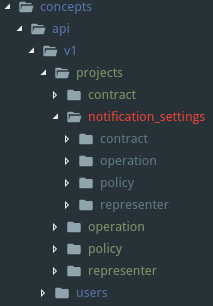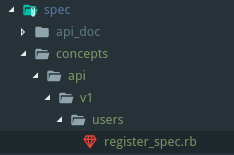It’s a business logic framework.
Trailblazer provides new high-level abstractions for Ruby frameworks. It gently enforces encapsulation, an intuitive code structure and gives you an object-oriented architecture.
Trailblazer gives you a high-level architecture for web applications. It extends the basic MVC pattern with new abstractions. Conventions that go far beyond database table naming or route paths let you focus on your application code, minimize bugs and improve the maintainability.
Controllers end up as lean HTTP endpoints. No business logic is to be found in the controller, they instantly delegate to their respective operation. By standardizing the business logic, new developers can be onboarded faster with help of our free documentation. Trailblazer’s patterns cover 75% of daily business code’s structure - you will feel the power of strong conventions within the first hours.
Trailblazer defines patterns for a better architecture, and gives you implementations to use those patterns in your applications. Your software will be better structured, more consistent and with stronger, faster, and way simpler tests.
Trailblazer uses railway oriented programming pattern. And in 2.1 release it’s possible to use more than two tracks (fail/success)
Railway oriented programming is a design pattern which helps us handle errors in our applications. Instead of relying on exceptions, we design our data and functions in a specific way.
Trailblazer’s file structure organizes by CONCEPT, and then by technology. It embraces the COMPONENT STRUCTURE of your code. The modular structure SIMPLIFIES REFACTORING in hundreds of legacy production apps. To avoid constants naming collision with your active_record models it’s better to name your concepts using plurals nouns.
Code structure example:
The goal of an operation is to encapsulate all business logic of one feature in an application. Since features (or functions) in web applications are often, very often, mapped to controller actions, sometimes operations are compared to controller actions, orchestrating all logic related to business except for HTTP-related code.
In particular, this means that neither HTTP code nor rendering is part of an operation.
A contract is an abstraction to handle validation of arbitrary data or object state. It is a fully self-contained object that is orchestrated by the operation. The actual validation can be implemented using Reform with ActiveModel::Validation or dry-validation, or a Dry::Schema directly without Reform. The Contract macros helps you defining contracts and assists with instantiating and validating data with those contracts at runtime.
Representers help to parse and render documents for JSON or XML APIs. After defining a representer, it can either parse an incoming document into an object graph, or, the other way round, serialize a nested object into a document.
Policy objects to handle authorization.
It’s ok to use nested concepts when your business logic belongs to specific scope. For example you have a project that has notification settings. You can place your notification_settings concept under projects.
In Trailblazer, you write operation integration tests. Operations encapsulate all business logic and are single-entry points to operate your application. There’s no needs to test contract/representer etc in isolation. You need to test your operation with all dependencies.
Step by step tutorial of creating rails application using trailblazer stack
Let's create new rails application using:
rails new api-app -T --database=postgresql --apiGemfile
# Trailblazer bundle
gem 'trailblazer-endpoint', github: 'trailblazer/trailblazer-endpoint'
gem 'trailblazer-rails'trailblazer-endpoint is generic HTTP handlers for operation results.
Trailblazer brings a lot of clarity to your controller logic, pushing you to create operations that have a clear workflow. Each operation returns a result object with enough information in it to evaluate what to do. The problem now lies on the code duplication that one is forced to write to evaluate a set of possible cases, generally solved the same way for each controller.
E.g. an unauthenticated request should always be resolved in the same way (exclude special cases)
From this idea, Endpoint gem came to life. Wrapping some of the most common cases with a common solution for them. This allows you to don't have to worry with the returning values of each of your operations.
Naturally, not everyone has common cases and, in the light of Trailblazer flexibility, you can override all the behavior at any level of the app.
This will automatically pull trailblazer and trailblazer-loader.
The Rspec team officially states controller specs are now discouraged. So we will implement request specs using json_matchers to match serialized responses.
Gemfile
group :development, :test do
gem 'rspec-rails'
end
group :test do
gem 'json_matchers'
endNext add devise gem to generate user model which we will use for authentication:
Gemfile
# Authentication
gem 'devise'Run devise installer to generate default config:
rails generate devise:installCreate user model using devise generator:
rails generate devise userRun migrations to create users table in the database:
rails db:migrateWe will use jsonapi-rb gem for serializing documents using jsonapi 1.0 specification.
Gemfile
gem 'jsonapi-rails', github: 'jsonapi-rb/jsonapi-rails'Dox generates API documentation from Rspec controller/request specs in a Rails application.
Gemfile
group :test do
gem 'dox', require: false
endStart with user registration endpoint
spec/requests/api/v1/user/registration_spec.rb
# frozen_string_literal: true
RSpec.describe 'Api::V1::User::Registration', type: :request do
include ApiDoc::V1::User::Registration::Api
describe 'POST #create' do
include ApiDoc::V1::User::Registration::Create
describe 'Success' do
let(:valid_params) do
{
email: FFaker::Internet.email,
password: '!1password',
password_confirmation: '!1password'
}.to_json
end
before { post '/api/v1/user/registration', params: valid_params, headers: json_api_headers }
it 'renders created user', :dox do
expect(response).to be_created
expect(response).to match_json_schema('user/registration')
end
end
end
endNow we have to make our spec pass.
Start with routes.
config/routes.rb
Rails.application.routes.draw do
# devise_for :users
# For details on the DSL available within this file, see http://guides.rubyonrails.org/routing.html
namespace :api do
namespace :v1 do
namespace :user do
resource :registration, only: :create
end
end
end
endWe can now generate expected json schema for our request spec.
You can find JsonApi Schema definition following this link JSON API schema example
Also you can use service like https://www.jsonschema.net/ to generate required json schemas.
spec/support/api/schemas/user/registration.json
{
"definitions": {},
"$schema": "http://json-schema.org/draft-07/schema#",
"$id": "file:/user/resgistration.json#",
"type": "object",
"title": "User Registration Schema",
"required": [
"data"
],
"properties": {
"data": {
"$id": "#/properties/data",
"type": "object",
"title": "The Data Schema",
"required": [
"id",
"type",
"attributes"
],
"properties": {
"id": {
"$id": "#/properties/data/properties/id",
"type": "string",
"title": "The Id Schema",
"default": "",
"examples": [
"14"
],
"pattern": "^(.*)$"
},
"type": {
"$id": "#/properties/data/properties/type",
"type": "string",
"title": "The Type Schema",
"default": "",
"examples": [
"users"
],
"pattern": "^(.*)$"
},
"attributes": {
"$id": "#/properties/data/properties/attributes",
"type": "object",
"title": "The Attributes Schema",
"required": [
"email"
],
"properties": {
"email": {
"$id": "#/properties/data/properties/attributes/properties/email",
"type": "string",
"title": "The Email Schema",
"default": "",
"examples": [
"email@email.em"
],
"pattern": "^(.*)$"
}
},
"additionalProperties": false
}
}
}
}
}Create default endpoint using trailblazer-endpoint with dry-matcher
app/endpoints/api/endpoint.rb
# frozen_string_literal: true
module Api
class Endpoint < Trailblazer::Endpoint
Matcher = Dry::Matcher.new(
created: Dry::Matcher::Case.new(
match: ->(result) { result.success? && result['model.action'] == :new },
resolve: ->(result) { result }
),
invalid: Dry::Matcher::Case.new(
match: ->(result) { result.failure? && result['result.contract.default'] && result['result.contract.default'].failure? },
resolve: ->(result) { result }
)
)
def matcher
Api::Endpoint::Matcher
end
end
endThis matcher will be used in the application controller to catch all regular operation results.
app/controllers/api_controller.rb
# frozen_string_literal: true
class ApiController < ApplicationController
include DefaultEndpoints
include JsonapiParsing
include JsonapiPointers
include JsonapiContentTypeRestriction
endapp/controllers/concerns/default_endpoints.rb
# frozen_string_literal: true
module DefaultEndpoints
protected
def default_handler
lambda do |m|
m.created do |result|
render jsonapi: result[:model], **result[:renderer_options], status: :created
end
m.invalid do |result|
render jsonapi_errors: result['contract.default'].errors,
class: {
'Reform::Form::ActiveModel::Errors': JSONAPI::Rails::SerializableActiveModelErrors
},
status: :unprocessable_entity
end
end
end
def endpoint(operation_class, _options = {}, &block)
Api::Endpoint.call(operation_class, default_handler, { params: params.to_unsafe_h }, &block)
end
endNow we can use endpoint method in all our actions.
controllers/api/v1/user/registrations_controller.rb
module Api
module V1
module User
class RegistrationsController < ApiController
def create
endpoint Api::V1::Users::Operation::Register
end
end
end
end
endNow request test will fail because we didn't implement operation for endpoint method.
Implement user register operation
app/concepts/api/users/operaion/register.rb
# frozen_string_literal: true
module Api::V1::Users::Operation
class Register < Trailblazer::Operation
step Model(User, :new)
step Contract::Build(constant: Api::V1::Users::Contract::Register)
step Contract::Validate()
step Contract::Persist()
step :renderer_options
def renderer_options(ctx, **)
ctx[:renderer_options] = {
class: {
User: Api::V1::Users::Representer::Register
}
}
end
end
endImplement user register contract using activemodel validations
app/concepts/api/users/contract/register.rb
# frozen_string_literal: true
module Api::V1::Users::Contract
class Register < Reform::Form
property :email
property :password
property :password_confirmation
validates :email, presence: true
validates :password, presence: true, length: { minimum: 6 }
validate :password_ok?
def password_ok?
errors.add(:password, I18n.t('errors.password_missmatch')) if password != password_confirmation
end
end
endImplement user register representer.
app/concepts/api/users/representer/register.rb
# frozen_string_literal: true
module Api::V1::Users::Representer
class Register < JSONAPI::Serializable::Resource
type 'users'
attributes :email
end
endMore complex feature implementation tutorial using trailblazer 2.0.7
- How to stub operation
- How to transform request params
- Manual validation
- Work with ActiveRecord transactions
- Nested operations
- Callable steps
- Composition over inheritance
- How to use decorator for represented resources
- Request spec
- Controller logic
- Operation spec
- Operation logic
- Contract logic
- Representer logic
- Внедрить в существующий проект. Что это даст, бонусы, для чего? В каких случаях хуже/лучше.
- Пример внедрения. Легаси.
- Форм обджект сложная. С несколькими сущностями.
- JSONapi specification.
- Reform populator, prepopulator, default.
- User & UserProfile & UserAddress




